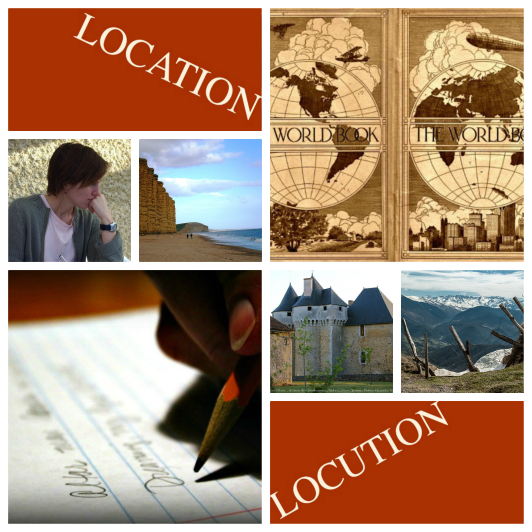
Tracey Warr is back with her latest interview guest, Harriet Springbett, an Englishwoman who is now rooted in south-western France and has seen her creative life blossom as a result.
Greetings, Displaced Nationers. My guest this month is Harriet Springbett, an English writer who lives in the Poitou-Charentes region of France with her French husband and their dual-nationality teenage daughters.
Harriet grew up in West Dorset. She qualified as a manufacturing engineer before discovering she preferred people to machines and words to numbers. It was the mid-1990s, and she thought about applying for an MA in creative writing, a degree that was rare at the time, but her boyfriend was French and she ended up moving to France to study French for a year at the Université de Pau. As she writes in one of her blog posts: “I finally opted for love in an exotic setting.” She settled down in France, and in addition to having a family has worked as a project manager, a freelance feature writer, a translator and an English teacher—while writing fiction in her spare time.
Now in her forties, Harriet has produced her debut novel, Tree Magic. Released this year in January by Impress Books, it’s a coming-of-age story about a 13-year-old girl named Rainbow, who has secret powers over trees: she can help them grow and heal. Reflecting Harriet’s own experience, Rainbow travels from England to France, but in Rainbow’s case the quest is to discover whether her ability to communicate with trees is a gift or a curse.
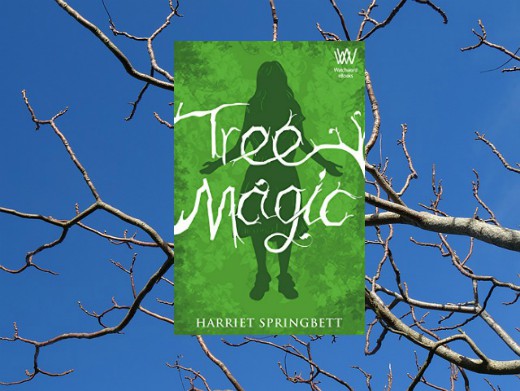
Harriet writes every morning and also maintains an author site, Harriet Springbett’s playground: Words and Thoughts about writing in France, where she covers writing, life in France, and French cultural events. Several of her short stories (e.g., “Quark Soup,” “Shingle and Sand,” “Ami Entends-tu?” and “Big Bones”) have been placed and shortlisted in competitions or published in magazines such as The French Literary Review.
* * *
Welcome, Harriet, to Location, Locution. My first question to you is: how has being “displaced” affected your writing? Has it affected what you write, how you write, that you write at all, or had some other effect?
Over the years I’ve realised that I write to keep in touch with my English origins. When I go back to England and see bookshops stuffed with books, or blogs featuring new books every day, I feel intimidated. Writing stories suddenly seems rather pointless and I wonder what I can possibly add to the overloaded bookshelves. Then I come home to France and it feels rare and right once more. France is my cocoon. If I lived in England, I’m not sure I’d be a writer. Living in France also means that I’m now uncomfortable writing about English settings because I lack familiarity with today’s England. This means that most of my work is set in France or in pre-1999 England.
Which comes first for you, story or location?
Actually, character comes first for my novels, but the location is usually attached to the character. I was fascinated to hear displaced novelist and academic author Patricia Duncker say that the location is often the part of a story that remains with the reader for longest—well after you’ve forgotten the characters and the plot. This is true for me as a reader, and as a writer I need to be able to visualize and sense the setting very clearly. The location grounds the story. At the moment I am writing a story set in the Pyrenees mountains, a place I love, so it’s a real pleasure for me to spend imagination time there.
What’s your technique for evoking the atmosphere of a place?
I write more easily about countryside locations than cities, maybe because I find that cities feel calculated whereas nature is full of coincidental oddities. When I describe places, I try to use all five senses, though not in a list, of course. Sometimes I will associate a smell or a sound with a place, so that when different characters are in the place they will experience the same sense, but colour it with their own perception according to their character or mood. In this way the reader learns about the character as well as the place. Other times I search for a metaphor or simile that describes the place as a whole and leave it to the reader to imagine the details.
Can you give us some examples of features create a sense of location: landscape, culture, food…?
That’s really difficult to pin down. All of these are important, along with language, and, of course, the light: some places have a dark, brooding light, while others have a brightness that bleaches them almost into two dimensions. But the most evocative features are often those you don’t expect. It’s important to spot little details that say a lot, and I love going out and about alone because this is when I play at putting words to what’s around me. On the subject of detail, I remember listening to Beatrice Colin talk about how to make historical fiction authentic: she said you don’t need to describe everything, just a few places—but you must do this in detail.
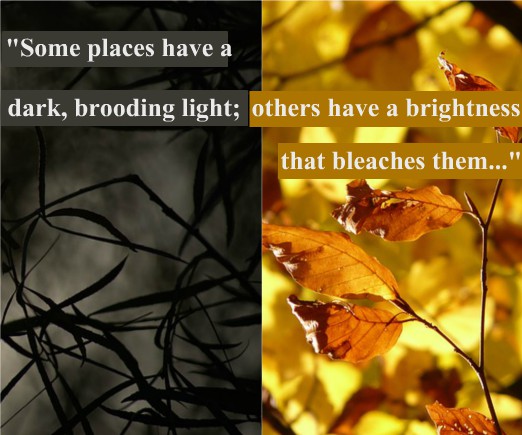
Can you give us an example from your novel, Tree Magic?
Here is a passage from the beginning of Chapter Two, when Rainbow is out selling tomatoes and arrives at the so-called Drunken House, on the outskirts of the village where she lives.
The Drunken House was the local horror spot, the place you had to go into alone if you lost at Forfeits. She’d only lost once, but the memory of invisible eyes watching her as she’d stood in the hall and counted to ten had been burnt into her mind forever. She’d stopped playing Forfeits with the village kids after that.
The house lurked on the inside of a bend in the dank lane and had been empty for years. Ivy-clad trees grew on the steep bank opposite, and its cold brick walls huddled in their shade. There weren’t any neighbouring houses. It crouched alone, full of ghosts who were just waiting for her to run home alone on a dark night so they could reach out and grab her.
Rainbow hurried past, clutching her bucket. She could feel the house’s dampness creeping out to her. It willed her to push open the rotting door and sacrifice her warm body to its hunger.
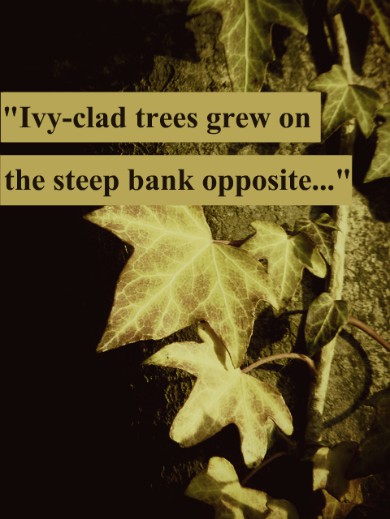
How well do you need to know the place before using it as a setting?
I don’t need to know it well but I do need to have a strong sense of it. I often have a real place in my mind as a starting point, which I then adapt to suit the needs of the story. This is the case with The Drunken House extract above: I know the place I mean, but it has changed in my mind to become this new place, which is part real, part fiction. The Chinese novelist and Nobel Laureate Mo Yan mentions this mix of real and imagined locations in his collection of essays Dépasser Le Pays Natal (roughly translated as “Surpassing Your Native Land”). He talks about how, when he returned to his childhood home after several decades of absence, he was surprised to find it different to the childhood home he’d remembered and described in his fiction. I can identify with this.
Last but not least, which writers do you admire for the way they use location?
I tend to find that most books I enjoy have evocative settings. Two authors come to mind immediately: in Philippe Claudel’s novel Brodeck’s Report, a kind of adult fairy tale, I am in those mountains alongside Brodeck. His skill in creating convincing locations is such that the French cartoonist Manu Larcenet was able to create a graphic novel based on this book, and its images, although somewhat darker, are very close to the pictures in my head. The other writer is Donna Tartt—particularly, The Little Friend, whose hot, sticky, Mississippi setting actually made me sweat. She’s the queen of sensory detail and I think this is why I inhabit her books so easily. And if she’s the queen, then British novelist Jon McGregor has to be the king (I hope they don’t mind me marrying them off like this!).
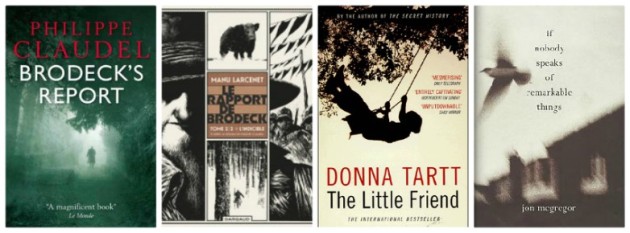
Harriet Springbeck’s picks for contemporary writers who have mastered the art of writing about (and in one case, illustrating!) place
Thanks so much, Harriet, for your answers. It’s been such a pleasure.
* * *
Readers, any questions for Harriet? Please leave them in the comments below.
Meanwhile, if you would like to discover more about Harriet Springbett and her creative output, I suggest you visit her “playground”. You can also follow her on Facebook and Twitter.
À bientôt! Till next time…
* * *
Thank you so much, Tracey and Harriet! Harriet, I can relate to the idea that you initially went to France as a love-pat, and although you thought it might mean relinquishing your writing career as you have expressed in this post, it seems you are now finding your way. Not only that but your displaced life has fed your creative urges. Kudos! —ML Awanohara
Tracey Warr is an English writer living mostly in France. She has published three early medieval novels with Impress Books: Conquest: Daughter of the Last King (2016), The Viking Hostage (2014), and Almodis the Peaceweaver (2011), as well as a future fiction novella, Meanda (2016), set on a watery exoplanet, as well as non-fiction books and essays on contemporary art. She teaches on creative writing courses in France with A Chapter Away.
STAY TUNED for next week’s fab posts!
If you enjoyed this post, we invite you to register for The Displaced Dispatch, a round up of biweekly posts from The Displaced Nation and much, much more. Register for The Displaced Dispatch by clicking here!
Related posts:
- LOCATION, LOCUTION: France-based English writer Jacqueline Yallop recommends a life of “being on the move”
- LOCATION, LOCUTION: Canadian author Dianne Ascroft lives, eats, breathes—and writes—Ireland, past and present
- LOCATION, LOCUTION: The sensuousness of the French Mediterranean infuses the works of actress-turned-author Carol Drinkwater
- LOCATION, LOCUTION: After spending summers in rural France, Stephen Goldenberg uses Villefranche as setting for murder mystery novel
- LOCATION, LOCUTION: For acclaimed British novelist Simon Mawer, not feeling at home anywhere fires creativity
Photo credits:
Top visual: The World Book (1920), by Eric Fischer via Flickr (CC BY 2.0); “Writing? Yeah.” by Caleb Roenigk via Flickr (CC BY 2.0); author photo and photos of West Dorset and French countryside via Pixabay. Other tree photos, including the one in the background of Springbett’s book cover, also via Pixabay.














Reblogged this on Harriet Springbett's playground and commented:
The Displaced Nation is a website that explores how it feels to live away from your country of birth – and I’d almost forgotten that I was interviewed by one of its columnists earlier this year.
The interview, which focuses on the importance of setting, has just been published.
Many thanks to Tracey Warr for the beautiful page design.
Hi there, ML Awanohara, and thanks for your comment. What a brilliant term you have used: “love-pat”. And yes, I guess we manage to overcome obstacles to do the things that really count – a bit like the roots of a tree that twist around underground rocks in their search for nutrients and water.
Pingback: Writing in exile – Tracey Warr Writing
Pingback: The Displaced Nation – Tracey Warr Writing
Pingback: One Year On | Harriet Springbett's playground